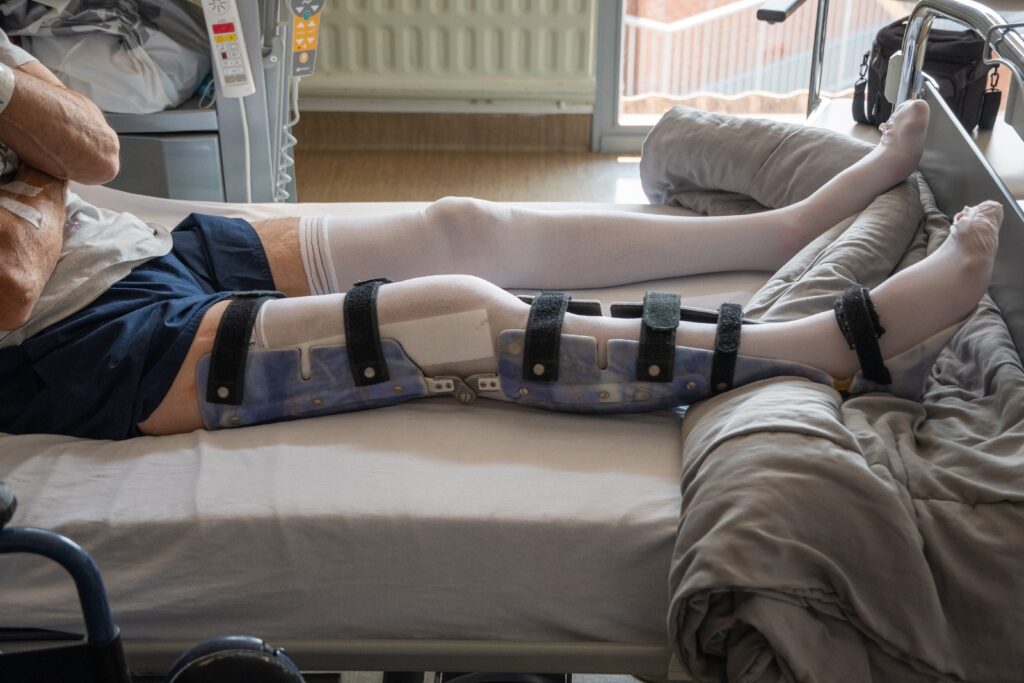A broken lower leg injury commonly occurs after a serious motor vehicle accident, work accident, or even a sport-related injury. It can also happen from many other incidents as well. With each of these causes, the risks and complications of a broken lower leg can be severe. You may face both emotional and financial hardships related to your broken leg.
We discuss what risks you face after a broken lower leg injury, how to protect your health, and what steps you can take to safeguard your legal rights.
What Is a Broken Lower Leg Injury?
A broken lower leg occurs when you suffer a fractured bone at or below the knee but above the ankle. This happens when the bone cracks, fractures, or entirely breaks. Within the lower leg are two primary bones – the fibula and the tibia.
The fibula and tibia are both long bones in your lower leg. They both connect the knee to the ankle, but each is separate from the other. They are connected with various muscles, ligaments, and other tissues. In many cases, the tibia and fibula are damaged together in an accident. It is possible to break only one of these bones, but their close proximity makes it highly likely that both bones will be broken simultaneously.
Tibia
The tibia is also known as the shinbone. It is larger than the fibula, connecting the knee joint to the ankle joint. The tibia in each leg carries the vast majority of your body’s weight, but it requires the assistance of the fibula to do so.
Fibula
The fibula is the smaller lower leg bone and runs beside the tibia. The top of the fibula is just below the knee joint and the lower part of the fibula forms part of your ankle joint. It helps stabilize the tibia but does not carry a substantial amount of weight.
Types of Lower Leg Fractures
Lower leg fractures are separated into different types. These types may depend on the way the injury manifests or how it happens. Common types of broken lower leg injuries include:
- Oblique fractures
- Spiral fractures
- Comminuted fractures
- Segmental fractures
- Transverse fractures
- Compound fractures
- Avulsion fractures
- Stress fractures
The symptoms you face and the treatment you need will likely depend on the type of lower leg fracture you face. For example, a displaced tibia or fibula fracture occurs when the break is so severe that it leaves a gap between the bones, rather than a simple crack through them. In these cases, the symptoms are likely more severe and the treatment more intensive to heal your leg.
Symptoms of a Broken Lower Leg Injury
Symptoms of a broken lower leg bone vary widely. Some fractures are relatively small and may cause discomfort and mild complications. Others, like compound or open fractures, can even be life-threatening.
The physical symptoms you might face after a broken lower leg include, but are not limited to:
- Tenderness in the affected area
- Minor to severe pain
- Swelling
- Inability to move your leg normally or at all
- Bruising and discoloration
- Bumps or deformities
- Skin, muscle, and ligament damage
These immediate symptoms may be alleviated quickly or take a great deal of time to heal. This will depend on your unique situation.
Risks of Complications
There are several potential long-term risks and complications that could occur from a broken tibia or fibula. These risks include:
- Nerve damage from broken bones or the trauma of the accident
- Damaged ligaments and muscles from compound fractures
- Inability to participate in activities you are used to, such as certain sports
- Amputation or loss of limb from severe broken bone injuries
- Osteoporosis
- Joint problems
Emotional and Psychological Risks of a Broken Lower Leg
In addition to the catastrophic physical injuries that may result from a broken lower leg, you may also face severe psychological and emotional harm. These harms can affect your mental health and overall well-being. These damages are often compensable in a personal injury lawsuit and may even be part of your treatment costs.
Emotional and psychological risks of a broken lower leg include:
- Pain and suffering
- Emotional trauma
- Post-traumatic stress
- Anxiety and depression
- Suicidal thoughts
- Flashbacks and nightmares about the accident
These emotional risks often couple with the physical risks to create severe harm to you and your family.
Financial Harm From Lower Leg Fractures
A lower leg break can negatively impact your finances in addition to everything else. It risks your financial freedom and security because of the high costs you likely face. You will likely face financial harm such as:
- Medical bills. You could suffer tens of thousands in hospital bills, emergency room fees, surgical costs, and much more.
- Rehabilitation services. Lower leg fractures often require long-term rehabilitation, treatment, and equipment to help you heal. These items and services are very expensive.
- Assistive devices. You will likely require casts, splints, and other stabilizing equipment on your leg while it heals. You may also require a walker or wheelchair to help you move while you recover. The hospital may require you to buy this equipment or rent it from them.
- Lost income. A lower leg fracture may make it difficult or impossible to work during your convalescence. Losing your wages could severely impact your financial well-being and your ability to support your family.
- Lost earning capacity. Many individuals with severe leg breaks never fully recover. When this happens, they may be unable to perform the work they did before. If a new job makes less income than your old job, you could be entitled to the difference in pay.
Next Steps After a Broken Lower Leg Injury
When you know the risks of a broken lower leg injury, you better understand what you can do to protect your rights. Focus on your health first and make sure you keep everything related to your injury. Speak with a personal injury attorney soon after the accident to protect your legal rights as well.
There are many risks of a broken lower leg, but you can stay ahead of them when you are informed.
SOURCES;









